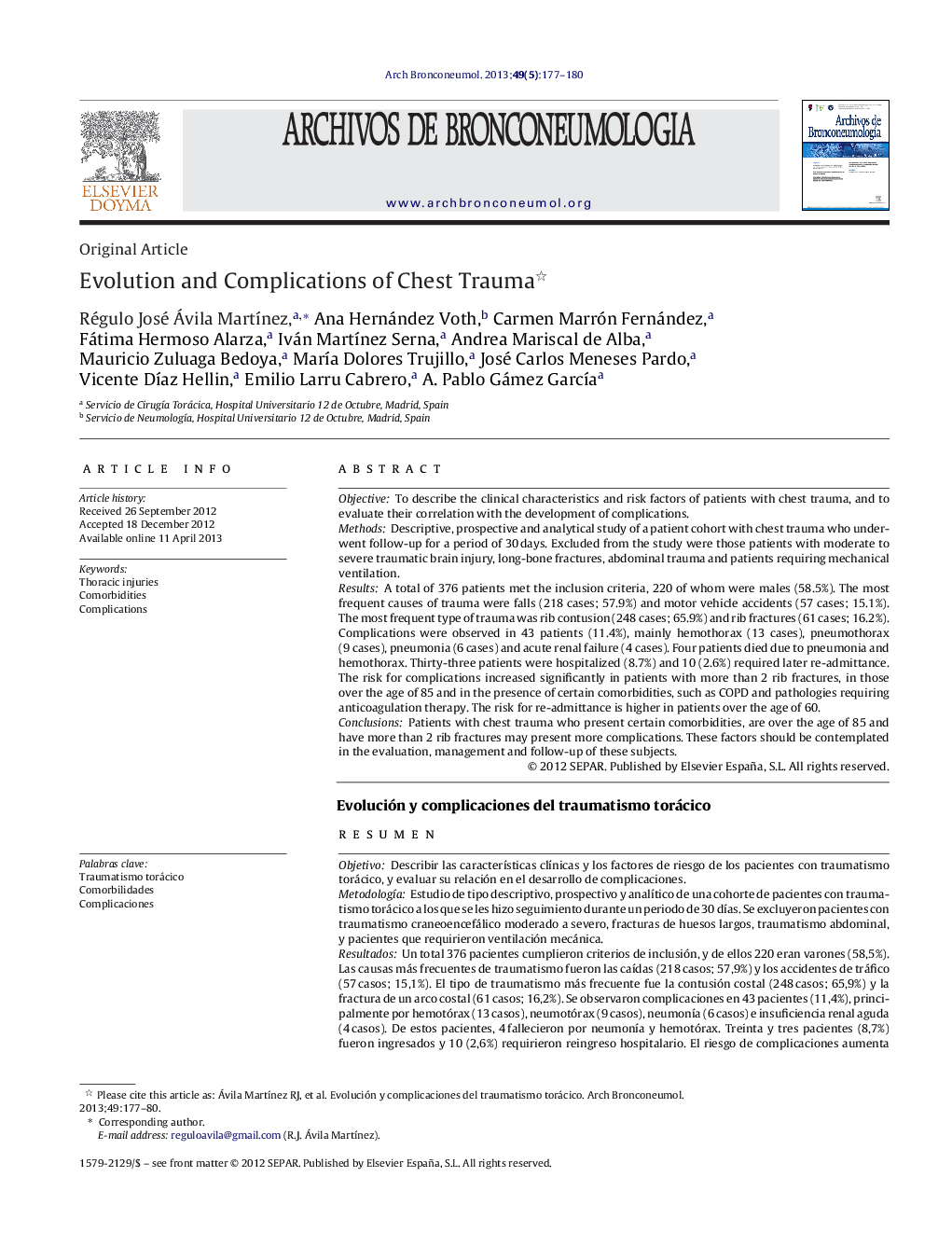| کد مقاله | کد نشریه | سال انتشار | مقاله انگلیسی | نسخه تمام متن |
|---|---|---|---|---|
| 4205915 | 1279945 | 2013 | 4 صفحه PDF | دانلود رایگان |

ObjectiveTo describe the clinical characteristics and risk factors of patients with chest trauma, and to evaluate their correlation with the development of complications.MethodsDescriptive, prospective and analytical study of a patient cohort with chest trauma who underwent follow-up for a period of 30 days. Excluded from the study were those patients with moderate to severe traumatic brain injury, long-bone fractures, abdominal trauma and patients requiring mechanical ventilation.ResultsA total of 376 patients met the inclusion criteria, 220 of whom were males (58.5%). The most frequent causes of trauma were falls (218 cases; 57.9%) and motor vehicle accidents (57 cases; 15.1%). The most frequent type of trauma was rib contusion (248 cases; 65.9%) and rib fractures (61 cases; 16.2%). Complications were observed in 43 patients (11.4%), mainly hemothorax (13 cases), pneumothorax (9 cases), pneumonia (6 cases) and acute renal failure (4 cases). Four patients died due to pneumonia and hemothorax. Thirty-three patients were hospitalized (8.7%) and 10 (2.6%) required later re-admittance. The risk for complications increased significantly in patients with more than 2 rib fractures, in those over the age of 85 and in the presence of certain comorbidities, such as COPD and pathologies requiring anticoagulation therapy. The risk for re-admittance is higher in patients over the age of 60.ConclusionsPatients with chest trauma who present certain comorbidities, are over the age of 85 and have more than 2 rib fractures may present more complications. These factors should be contemplated in the evaluation, management and follow-up of these subjects.
ResumenObjetivoDescribir las características clínicas y los factores de riesgo de los pacientes con traumatismo torácico, y evaluar su relación en el desarrollo de complicaciones.MetodologíaEstudio de tipo descriptivo, prospectivo y analítico de una cohorte de pacientes con traumatismo torácico a los que se les hizo seguimiento durante un periodo de 30 días. Se excluyeron pacientes con traumatismo craneoencefálico moderado a severo, fracturas de huesos largos, traumatismo abdominal, y pacientes que requirieron ventilación mecánica.ResultadosUn total 376 pacientes cumplieron criterios de inclusión, y de ellos 220 eran varones (58,5%). Las causas más frecuentes de traumatismo fueron las caídas (218 casos; 57,9%) y los accidentes de tráfico (57 casos; 15,1%). El tipo de traumatismo más frecuente fue la contusión costal (248 casos; 65,9%) y la fractura de un arco costal (61 casos; 16,2%). Se observaron complicaciones en 43 pacientes (11,4%), principalmente por hemotórax (13 casos), neumotórax (9 casos), neumonía (6 casos) e insuficiencia renal aguda (4 casos). De estos pacientes, 4 fallecieron por neumonía y hemotórax. Treinta y tres pacientes (8,7%) fueron ingresados y 10 (2,6%) requirieron reingreso hospitalario. El riesgo de complicaciones aumenta significativamente en pacientes con más de 2 fracturas costales, en mayores de 85 años y en presencia de algunas comorbilidades como la EPOC y patologías que requieren anticoagulación. El riesgo de reingreso es mayor en pacientes con más de 60 años.ConclusionesLos pacientes con traumatismo torácico que presentan algunas comorbilidades, son mayores de 85 años y tienen más de 2 fracturas costales pueden presentar más complicaciones, y se deben considerar estos factores en su evaluación, manejo y seguimiento.
Journal: Archivos de Bronconeumología (English Edition) - Volume 49, Issue 5, May 2013, Pages 177–180